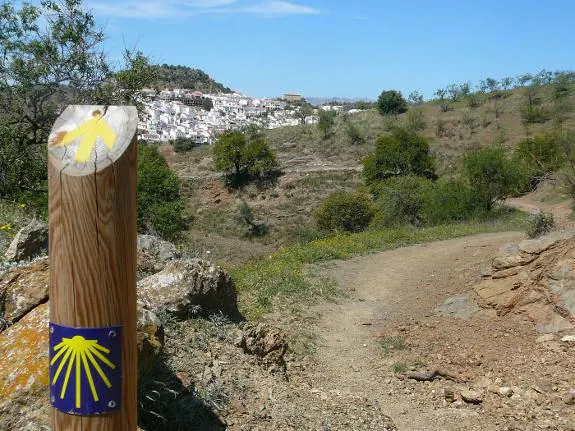Malaga's own mini Camino de Santiago
A stretch of the famous Way of Saint James runs through the heart of the province
Mark Nayler
Viernes, 15 de marzo 2019, 16:32
The path starts opposite the Día supermarket, on the main drag - an unlikely place to begin walking a section of one of the world's greatest pilgrimages. A newish-looking sign directed me uphill to the edge of the village and within ten minutes I was amidst olive groves and brightly coloured blossom.
The only sounds were the droning of bees and birdsong. To my right, the cliffs of El Torcal natural park reached into a deep blue sky. Climbing steadily, I left Villanueva de la Concepción behind, eager to see what other sights awaited me on the 15-kilometre path to Antequera.
Weaving through the heart of Malaga province, this rarely-trodden track is part of the Camino de Santiago (or Way of Saint James), the Spanish pilgrimage that's more associated with its northern sections, particularly the French Way.
This epic route runs for 770 kilometres between St Jean Pied de Port in the French Pyrenees and Santiago de Compostela in Galicia, taking in the landmark cities of Pamplona, Logroño, Burgos and León and requiring about a month to complete. In the 2010 film The Way (well worth a watch), Martin Sheen's character Tom Avery walks along this part of the Camino in memory of his son, who is killed by a storm in the Pyrenees while on his own pilgrimage.
The Andalusian sections of the Way of St James are collectively known as the Camino Mozárabe de Santiago and, although they've yet to star in a film about the pilgrimage, are every bit as spectacular as their northern cousins.
They begin in Malaga and Almeria, join at Baena, then snake up to Santiago via Cordoba, Mérida and Salamanca. These routes take their name from the Mozarabs - Christians who retained their own religion and customs while living in medieval Moorish Spain.
Add-ons or alternatives to the walk I did a few weeks ago include the path that takes you from Malaga to Almogía (22 kilometres) and the staggeringly beautiful section between Almogía and Villanueva (20 kilometres).
But for a fairly undemanding hike through some of Malaga's most dramatic countryside, the Villanueva-Antequera track is ideal.
I walked it on a sunny Friday morning, during the Día de Andalucía - a weekend when you might have expected to see plenty of budding pilgrims about. But because these Mozarab routes are still fairly obscure, the only other person I saw was a farmer taking a morning stroll outside Villanueva. My mini-camino was therefore walked in solitude and silence - fitting preparation for taking on a bigger chunk of the pilgrimage later this year.
Any concerns I had about getting lost in the wilderness quickly disappeared. The route is frequently punctuated with posts bearing the blue-and-yellow Camino logo and arrows painted onto rocks. These become almost like companions, keeping you on the right track as you weave through the unspoilt countryside at the foot of El Torcal.
The path is at its most dramatic as it cuts between El Torcal's peaks, bringing you down onto the final approach to Antequera. These limestone formations make up one of the most striking karst landscapes in Europe, and were at the bottom of the ocean 150 million years ago.
In the middle of the Torcal pass, before a slightly tricky descent begins, Antequera comes into view for the first time - a giant snowflake topped by a medieval fortress, with the iconic Peña de los Enamorados peak in the background.
Although it still looked quite far off at this point, my final destination was actually just four kilometres away. I was enjoying the track so much, though, that I would happily have carried on for hours.
I thought of a close friend of mine, who cycled several hundred kilometres along the French Way into Santiago a few years ago; she told me that she cried when she reached the end of her Camino because she was so sad it was over.
Much shorter as my southern pilgrimage was, it enabled me to understand how she must have felt as she entered Santiago's great cathedral - the end of the road for weary and emotional , wherever their starting points.
Urban finish
Walking into a town or city is something we rarely, if ever, do these days. We cruise in by car or train, paying little attention to how urban areas fit into their natural surroundings. But the final section of this route makes you realise how suddenly Antequera begins. One moment it's all rocky plains and lonely , their canine sentries barking ferociously as you pass; but minutes later you're coming down Calle de Jesús, surrounded by locals going about their daily business.
It was only here that I realised I'd been in a sort of trance for the last three hours, a zen-like state induced by nature, solitude and silence. My mini-camino sadly over, I entered the first bar I came to for an internal debrief and a beer.
With a soundtrack provided by the animated conversations of locals (most of them knocking back brandy, although it was barely eleven in the morning), I reflected on the walk. I knew straight away that I couldn't just leave it there: something about spending a few hours on this ancient path had made a deep impression on me.
Partly for this reason - and partly to dedicate my pilgrimage to a family member who has recently endured much hardship - I'm planning to walk a 400-kilometre stretch of the Camino Mozárabe, from Zamora to Santiago, in May.
It seems to be true what they say, although before I thought it sounded like pretentious rubbish: the Camino chooses you, and not the other way around.
